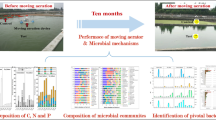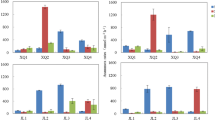Abstract
In this research, the dynamics of nitrogen transformation and bacterial community in malodorous river were investigated with different aeration depths. Computational flow dynamics (CFD) and Reynolds number (Re) were specially used to characterize the hydrodynamics condition under different aeration depths. The results indicated that aeration depth had vital impact on nitrogen transformation and bacterial community structure. It was found that a range of aeration depth (0.20–0.45 m above sediment–water interface) facilitated the removal of NH4+-N and TN with Re ranging between 6211 and 8930. Proteobacteria took over Firmicutes to become the predominant phylum (36–78%) under aeration, and the main subdivisions of γ-, β- and δ-Proteobacteria also varied greatly with different aeration depths. Interestingly, there was a marked shift of the inferentially identified dominant functional role within Proteobacteria from organic-matter degradation to nitrogen metabolism and then to sulfur metabolism as well as the coupling of nitrogen and sulfur with the increase of disturbance. The redundancy analysis (RDA) further confirmed the importance of aeration disturbance in shaping bacterial community. These findings help to gain improved understanding of endogenous N-behavior and aquatic microbial ecology, and underline the need for integrating the hydrodynamics factors with microbial community.
Graphic abstract








Similar content being viewed by others
References
Abbasian F, Lockington R, Megharaj M, Naidu R (2016) The biodiversity changes in the microbial population of soils contaminated with crude oil. Curr Microbiol 72:663–670
Abell GCJ, Mcorist AL (2007) Assessment of the diversity and stability of faecal bacteria from healthy adults using molecular methods. Microb Ecol Health Dis 19:229–240
Anantharaman K, Brown CT, Hug LA, Sharon I, Castelle CJ, Probst AJ, Thomas BC, Singh A, Wilkins MJ, Karaoz U, Brodie EL, Williams KH, Hubbard SS, Banfield JF (2016) Thousands of microbial genomes shed light on interconnected biogeochemical processes in an aquifer system. Nat Commun 7:13219
APHA (2012) Standard methods for the examination of water and wastewater, 22nd edn. APHA and AWWA and WEF, Washington
Bao LL, Wang XY, Chen YJ (2016) Abundance and distribution of ammonia-oxidizing microorganisms in the sediments of Beiyun River, China. Ann Microbiol 66:1075–1086
Beller HR, Chain PS, Letain TE, Chakicherla A, Larimer FW, Richardson PM, Coleman MA, Wood AP, Kelly DP (2006) The genome sequence of the obligately chemolithoautotrophic, facultatively anaerobic bacterium Thiobacillus denitrificans. J Bacteriol 188:1473–1488
Bowman JP, McCuaig RD (2003) Biodiversity, community structural shifts, and biogeography of prokaryotes within antarctic continental shelf sediment. Appl Environ Microbiol 69:2463–2483
Cao QQ, Wang H, Chen XC, Wang RQ, Liu J (2017) Composition and distribution of microbial communities in natural river wetlands and corresponding constructed wetlands. Ecol Eng 98:40–48
Chen YJ, Liu Y, Wang XY (2017) Spatiotemporal variation of bacterial and archaeal communities in sediments of a drinking reservoir, Beijing, China. Appl Microbiol Biotechnol 101:3379–3391
Deng G, Yang W, Zhou G, Li Y, Liu S (2014) Heavy metals and polycyclic aromatic hydrocarbons in sediments from the Shenzhen River, South China. Environ Sci Pollut Res 21:10594–10600
Drury B, Rosi-Marshall E, Kelly JJ (2013) Wastewater treatment effluent reduces the abundance and diversity of benthic bacterial communities in urban and suburban rivers. Appl Environ Microbiol 79:1897–1905
Du HX, Harata N, Li FS (2018) Responses of riverbed sediment bacteria to heavy metals: Integrated evaluation based on bacterial density, activity and community structure under well-controlled sequencing batch incubation conditions. Water Res 130:115–126
Ferrer M, Guazzaroni ME, Richter M, García-Salamanca A, Yarza P, Suárez-Suárez A, Solano J, Alcaide M, van Dillewijn P, Molina-Henares MA, López-Cortés N, Al-Ramahi Y, Guerrero C, Acosta A, de Eugenio LI, Martínez V, Marques S, Rojo F, Santero E, Genilloud O, Pérez-Pérez J, Rosselló-Móra R, Ramos JL (2011) Taxonomic and functional metagenomic profiling of the microbial community in the anoxic sediment of a sub-saline shallow lake (laguna de carrizo, central spain). Microb Ecol 62:824–837
Gabor EM, de Vries EJ, Janssen DB (2003) Efficient recovery of environmental DNA for expression cloning by indirect extraction methods. FEMS Microbiol Ecol 44:153–163
Galand PE, Lucas S, Fagervold SK, Peru E, Pruski AM, Vetion G, Dupuy C, Guizien K (2016) Disturbance increases microbial community diversity and production in marine sediments. Front Microbiol 7:1950
He Y, Chen YX, Zhang YF, Huang MS (2013) Role of aerated turbulence in the fate of endogenous nitrogen from malodorous river sediments. Environ Eng Sci 30:11–16
He Y, Li Z, Yao L, Zhao YC, Huang MS, Zhou GM (2014) Molecular phylogenetic analysis of dominant microbial populations in aged refuse. World J Microbiol Biotechnol 30:1037–1045
He T, Guan W, Luan ZY, Xie SG (2016) Spatiotemporal variation of bacterial and archaeal communities in a pilot-scale constructed wetland for surface water treatment. Appl Microbiol Biotechnol 100:1479–1488
Lentini CJ, Wankel SD, Hansel CM (2012) Enriched Iron (III)-reducing bacterial communities are shaped by carbon substrate and iron oxide mineralogy. Front Microbiol 3:404
Li D, Jiang X, Wang JZ, Wang K, Zheng BH (2017) Effect of sewage and industrial effluents on bacterial and archaeal communities of creek sediments in the Taihu basin. Water 9:373
Liu YY, Liu CX, Nelson WC, Shi L, Xu F, Liu YD, Yan A, Zhong LR, Thompson C, Fredrickson JK, Zachara JM (2017) Effect of water chemistry and hydrodynamics on nitrogen transformation activity and microbial community functional potential in hyporheic zone sediment columns. Environ Sci Technol 51:4877–4886
Liu HQ, Hu Z, Zhang YJ, Zhang J, Xie HJ, Liang S (2018) Microbial nitrogen removal of ammonia wastewater in poly (butylenes succinate)-based constructed wetland: effect of dissolved oxygen. Appl Microbiol Biotechnol 102:9389–9398
Lu XM, Lu PZ (2014) Diversity, abundance, and spatial distribution of riverine microbial communities response to effluents from swine farm versus farmhouse restaurant. Appl Microbiol Biotechnol 98:7597–7608
Nakamura Y, Satoh H, Kindaichi T, Okabe S (2006) Community structure, abundance, and in situ activity of nitrifying bacteria in river sediments as determined by the combined use of molecular techniques and microelectrodes. Environ Sci Technol 40:1532–1539
Pan M, Zhao J, Zhen SC, Heng S, Wu J (2016) Effects of the combination of aeration and biofilm technology on transformation of nitrogen in black-odor river. Water Sci Technol 74:655–662
Paredes-Sabja D, Setlow P, Sarker MR (2011) Germination of spores of Bacillales and Clostridiales species: mechanisms and proteins involved. Trends Microbiol 19:85–94
Ramos-Padrón E, Bordenave S, Lin SP, Bhaskar IM, Dong XL, Sensen CW, Fournier J, Voordouw G, Gieg LM (2011) Carbon and sulfur cycling by microbial communities in a gypsum-treated oil sands Tailings pond. Environ Sci Technol 45:439–446
Roberto AA, Van Gray JB, Leff LG (2018) Sediment bacteria in an urban stream: Spatiotemporal patterns in community composition. Water Res 134:353–369
Sherry A, Gray ND, Ditchfield AK, Aitken CM, Jones DM, Roling WFM, Hallmann C, Larter SR, Bowler BFJ, Head IM (2013) Anaerobic biodegradation of crude oil under sulphate-reducing conditions leads to only modest enrichment of recognized sulphate-reducing taxa. Int Biodeterior Biodegrad 81:105–113
Su XM, Xue BB, Wang YY, Hashmi MZ, Lin HJ, Chen JR, Mei RW, Wang Z, Sun FQ (2019) Bacterial community shifts evaluation in the sediments of Puyang River and its nitrogen removal capabilities exploration by resuscitation promoting factor. Ecotoxicol Environ Saf 179:188–197
Tang YQ, Li M, Zou YA, Lv MY, Sun JM (2018) Mechanism of aerobic denitrifiers and calcium nitrate on urban river sediment remediation. Int Biodeterior Biodegrad 126:119–130
Thoetkiattikul H, Mhuantong W, Pinyakong O, Wisawapipat W, Yamazoe A, Fujita N, Eurwilaichitr L, Champreda V (2017) Culture-independent study of bacterial communities in tropical river sediment. Biosci Biotechnol Biochem 81:200–209
Tomasek AA, Barman TD, Wang P, Kozarek JL, Staley C, Sadowsky MJ, Hondzo M (2018) The effects of turbulence and carbon amendments on nitrate uptake and microbial gene abundances in stream sediment. J Geophys Res-Biogeo 123:1289–1301
Velmurugan N, Kalpana D, Cho JY, Lee GH, Park SH, Lee YS (2011) Phylogenetic analysis of culturable marine bacteria in sediments from South Korean Yellw Sea. Microbiology 80:261–272
Wang H, Yi P, Zhang SJ, Liu YP, Tao Y, Zhou J, Liu XC (2012) Functional microbial community composition analysis in the laboratory-scale stable partial nitrifying-ANAMMOX municipal wastewater reactor. J Grad Univ Chin Acad Sci 29:38–45 (in Chinese)
Wang JH, He Y, Zhu J, Guan HM, Huang MS (2017) Screening and optimizing of inhibitors for ammonia-oxidizing bacteria in sediments of malodorous river. Appl Microbiol Biotechnol 101:6193–6203
Wang LQ, Li Y, Niu LH, Zhang WL, Zhang HJ, Wang LF, Wang PF (2018) Response of ammonia oxidizing archaea and bacteria to decabromodiphenyl ether and copper contamination in river sediments. Chemosphere 191:858–867
Wei GS, Li MC, Li FG, Li H, Gao Z (2016) Distinct distribution patterns of prokaryotes between sediment and water in the Yellow River estuary. Appl Microbiol Biotechnol 100:9683–9697
Yakhot V, Orzag SA (1986) Renormalization group analysis of turbulence: basic theory. J Sci Comput 1:3–11
Yin HB, Wang JF, Zhang RY, Tang WY (2019) Performance of physical and chemical methods in the co-reduction of internal phosphorus and nitrogen loading from the sediment of a black odorous river. Sci Total Environ 663:68–77
Zhang XY, Han XX, Chen XL, Dang HY, Xie BB, Qin QL, Shi M, Zhou BC, Zhang YZ (2015) Diversity of cultivable protease-producing bacteria in sediments of Jiaozhou Bay, china. Front Microbiol 6:1021
Zhao XY, Fan YY, Xi BD, Tan WB, He XS, Zhang H, Li D (2018) A regulating method for humic-reducing microorganisms and assessment of the reduction of reduction of dissimilatory Fe(III) in composting. China Environ Sci 38:3815–3822 (in Chinese)
Zheng YL, Hou LJ, Newell S, Liu M, Zhou JL, Zhao H, You LL, Cheng XL (2014) Community dynamics and activity of ammonia-oxidizing prokaryotes in intertidal sediments of the Yangtze Estuary. Appl Environ Microbiol 80:408–419
Zhu J, He Y, Wang JH, Qiao ZC, Wang Y, Huang MS (2017) Impact of aeration disturbances on endogenous phosphorus fractions and their algae growth potential from malodorous river sediment. Environ Sci Pollut Res 24:8062–8070
Zoppini A, Ademollo N, Amalfitano S, Casella P, Patrolecco L, Polesell S (2014) Organic priority substances and microbial processes in river sediments subject to contrasting hydrological conditions. Sci Total Environ 484:74–83
Acknowledgements
This work was supported by National Natural Science Foundation of China (41877477), Shanghai Natural Science Foundation (16ZR1408800), Shanghai Pujiang Talent Program (16PJD023), Shanghai Science and Technology Development Funds (18DZ1203806), and the Research Funds of The Guangxi Key Laboratory of Theory and Technology for Environmental Pollution Control (1701K005).
Author information
Authors and Affiliations
Corresponding author
Ethics declarations
Conflict of interest
The authors declare that they have no conflict of interest.
Ethical approval
This article does not contain any studies with human participants or animals performed by any of the authors.
Additional information
Publisher's Note
Springer Nature remains neutral with regard to jurisdictional claims in published maps and institutional affiliations.
Electronic supplementary material
Below is the link to the electronic supplementary material.
Rights and permissions
About this article
Cite this article
Chen, J., He, Y., Wang, J. et al. Dynamics of nitrogen transformation and bacterial community with different aeration depths in malodorous river. World J Microbiol Biotechnol 35, 196 (2019). https://doi.org/10.1007/s11274-019-2773-z
Received:
Accepted:
Published:
DOI: https://doi.org/10.1007/s11274-019-2773-z




